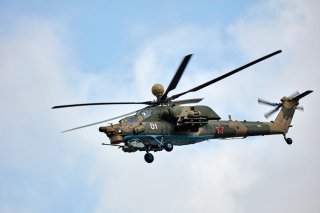Attack of the Drones—Ukrainian UAV Downed Russian Helicopter
Earlier this month, Kyiv claimed it destroyed a Russian Mi-28 anti-armor attack helicopter over the Russian region of Kursk.
Countless tanks have been destroyed by small unmanned aerial systems in the war in Ukraine. Both sides use small drones and loitering munitions to target their enemy’s armor, and David often beats Goliath in these encounters.
Ukraine started to use commercial drones against tanks almost immediately after Russia launched its unprovoked invasion in late February 2022. Russia followed suit, and both sides continue to develop counter-drone technology.
Ukraine has also used drones to strike Russian Navy warships in occupied Crimea, and recently, drones were employed against a Russian Tu-22M3 bomber at the Olenya military airfield in Murmansk Oblast, deep within the Arctic Circle.
Earlier this month, Kyiv claimed it destroyed a Russian Military Mi-28 anti-armor attack helicopter over the Russian region of Kursk. It reportedly marks the first time that a first-person view drone was used to down a manned aircraft in combat. Videos and photos shared on Telegram confirmed the destruction of the Russian helicopter.
“The Ukrainian drone pilot in the possible Wednesday shoot-down was very skilled or lucky or both. They spotted the 12-ton, three-crew Russian helicopter, which performs attack, transport and medical-evacuation missions while it was still close to the ground,” wrote David Axe, who also acknowledged that Russian bloggers claimed a ground-based launcher downed the helicopter.
However, Axe noted, “Ukrainian drone operators have become extremely adept at targeting the most vulnerable parts of Russian targets: flying drones into the open hatches of armored personnel carriers, under the add-on armor on so-called ‘turtle tanks’ and through the doors of reinforced infantry dugouts.”
Striking the rotor disc of the Mi-28 may have been easy business for a skilled drone operator, and Kyiv maintains it was a drone that struck the aircraft last week. Two other Russian helicopters—including another Mi-28 and a Mil Ka-52—were also reported to have been shot down in the same region. That could have led to the confusion on what actually took down the chopper.
Try and Try Again
Ukrainian drone operators have been trying for some time to score a kill on an aerial vehicle—last September, a drone tried but failed to intercept a Ka-52. Striking a moving target on the ground has proven hard enough, but operators from both Russia and Ukraine have managed to succeed.
Targeting an aircraft is far more challenging, given that small drones lack the speed of helicopters. This is why most of the UAS have gone after fighters and bombers on the ground rather than in the air. Yet the fact that an attack helicopter was likely taken out while close to the ground—where it needs to operate in order to strike enemy armor and forward positions—simply highlights how remotely controlled platforms are changing dynamics on the modern battlefield.
Once again David’s sling proved able to take out Goliath.
About the author
Peter Suciu is a Michigan-based writer. He has contributed to more than four dozen magazines, newspapers, and websites with over 3,200 published pieces over a twenty-year career in journalism. He regularly writes about military hardware, firearms history, cybersecurity, politics, and international affairs. Peter is also a Contributing Writer for Forbes and Clearance Jobs. You can follow him on Twitter: @PeterSuciu. You can email the author: [email protected].
Image: Evgeniyqw / Shutterstock.com

